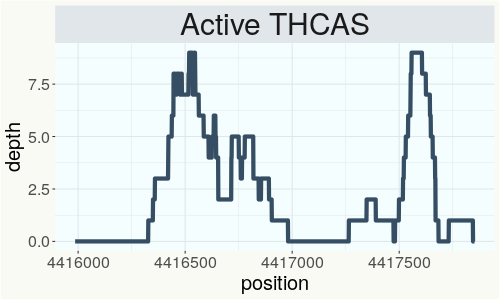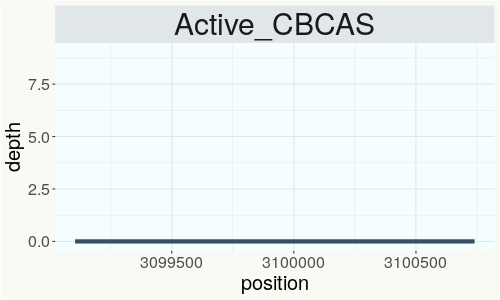Blueberry Cheesecake
RSP 10671
Grower: NA
General Information
- Sample Name
- Blueberry Cheesecake Yellow Clone Gen2_23JAN2017
- Accession Date
- February 14, 2017
- Reported Plant Sex
- Female
- Report Type
- StrainSEEK v2 3.2Mb
- DNA Extracted From
- Stem
The strain rarity visualization shows how distant the strain is from the other cultivars in the Kannapedia database. The y-axis represents genetic distance, getting farther as you go up. The width of the visualization at any position along the y-axis shows how many strains there are in the database at that genetic distance. So, a common strain will have a more bottom-heavy shape, while uncommon and rare cultivars will have a visualization that is generally shifted towards the top.
Chemical Information
Cannabinoid and terpenoid information provided by the grower.
Cannabinoids
No information provided.
Terpenoids
No information provided.
Genetic Information
- Plant Type
- Type II
File Downloads
The bell curve in the heterozygosity visualization shows the distribution of heterozygosity levels for cannabis cultivars in the Kannapedia database. The green line shows where this particular strain fits within the distribution. Heterozygosity is associated with heterosis (aka hybrid vigor) but also leads to the production of more variable offspring. When plants have two genetically different parents, heterozygosity levels will be higher than if it has been inbred or backcrossed repeatedly.
The ratio of reads mapped to Y-contigs to reads mapped to the whole Cannabis genome (Y-ratios) has been demonstrated to be strongly correlated with plant sex typing. This plot shows the distribution of Y-ratios for all samples in our database which were sequenced with the same method (panel or WGS) as this sample and where this sample falls in the distribution.

This chart represents the Illumina sequence coverage over the Bt/Bd allele. These are the three regions in the cannabis genome that impact THCA, CBDA, CBGA production. Coverage over the Active CBDAS gene is highly correlated with Type II and Type III plants as described by Etienne de Meijer. Coverage over the THCA gene is highly correlated with Type I and Type II plants but is anti-correlated with Type III plants. Type I plants require coverage over the inactive CBDA loci and no coverage over the Active CBDA gene. Lack of coverage over the Active CBDA and Active THCA allele are presumed to be Type IV plants (CBGA dominant). While deletions of entire THCAS and CBDAS genes are the most common Bt:Bd alleles observed, it is possible to have plants with these genes where functional expression of the enzyme is disrupted by deactivating point mutations (Kojoma et al. 2006).



This chart represents the Illumina sequence coverage over the CBCA synthase gene.

Variants (THCAS, CBDAS, and CBCAS)
No variants to report
Variants (Select Genes of Interest)
| DXR-1 | c.139A>G | p.Arg47Gly | missense variant | moderate | contig380 | 235296 | T/C |
|
| HDS-2 |
c.82_93delGT |
p.Val28_Thr3 |
conservative inframe deletion | moderate | contig95 | 1989748 |
CGTAACCGGAAC |
|
| HDS-2 | c.127T>G | p.Ser43Ala | missense variant | moderate | contig95 | 1989794 | T/G |
|
Nearest genetic relatives (All Samples)
- 0.005 Blueberry Cheesecake (RSP10672)
- 0.005 Blueberry Cheesecake (RSP10670)
- 0.043 JL#2 (RSP11076)
- 0.181 BlueBerry Cheesecake x JL Male (RSP11201)
- 0.191 Blueberry Cheesecake (RSP10646)
- 0.212 Blueberry Cheesecake (RSP10684)
- 0.230 RKM-2018-031 (RSP11123)
- 0.235 Joy (RSP11380)
- 0.235 Lift (RSP11378)
- 0.237 Serious Happiness (RSP10763)
- 0.238 Harlox (RSP10641)
- 0.238 Badger (RSP11614)
- 0.239 Electra (RSP11366)
- 0.245 Durban Poison (RSP11014)
- 0.247 JL Compost (RSP11657)
- 0.248 Queen Jesus (RSP10105)
- 0.251 CST (RSP11002)
- 0.251 Durban Poison #1 (RSP11013)
- 0.251 Suver Haze (RSP11364)
- 0.251 SPQ -quite resistant- (RSP11370)
Most genetically distant strains (All Samples)
- 0.405 Cherry Blossom (RSP11323)
- 0.402 Cherry Blossom CBG (RSP11303)
- 0.399 Big Bud (SRR14708270)
- 0.395 Cherry Blossom (RSP11301)
- 0.394 Cherry Blossom (RSP11328)
- 0.390 Feral (RSP11205)
- 0.390 Cherry Blossom (RSP11309)
- 0.390 Feral (RSP10890)
- 0.390 JL 3rd Gen Father (RSP11196)
- 0.389 Kush Hemp E1 (RSP11128)
- 0.387 80E (RSP11213)
- 0.387 RKM-2018-026 (RSP11118)
- 0.385 R1in136 (SRR14708226)
- 0.385 Cherry Blossom (RSP11329)
- 0.384 Cherry Blossom (RSP11298)
- 0.384 80E (RSP11212)
- 0.382 Red Eye OG (RSP11190)
- 0.381 Cherry Blossom (RSP11306)
- 0.381 Cherry Blossom (RSP11317)
- 0.379 Cherry Blossom (RSP11333)
Nearest genetic relative in Phylos dataset
- Overlapping SNPs:
- 101
- Concordance:
- 67
Nearest genetic relative in Lynch dataset
- Overlapping SNPs:
- 3
- Concordance:
- 3
Blockchain Registration Information
- Transaction ID
-
801be8e380fb3765
18a57d8305fb46a4 ef594d1e47209c04 70c4c38836121c19 - Stamping Certificate
- Download PDF (852.2 KB)
- SHASUM Hash
-
accfe3809ac87b1dd523f8fd8bfebc67 4c36a770499c85ee 191e3208f2a9c97c